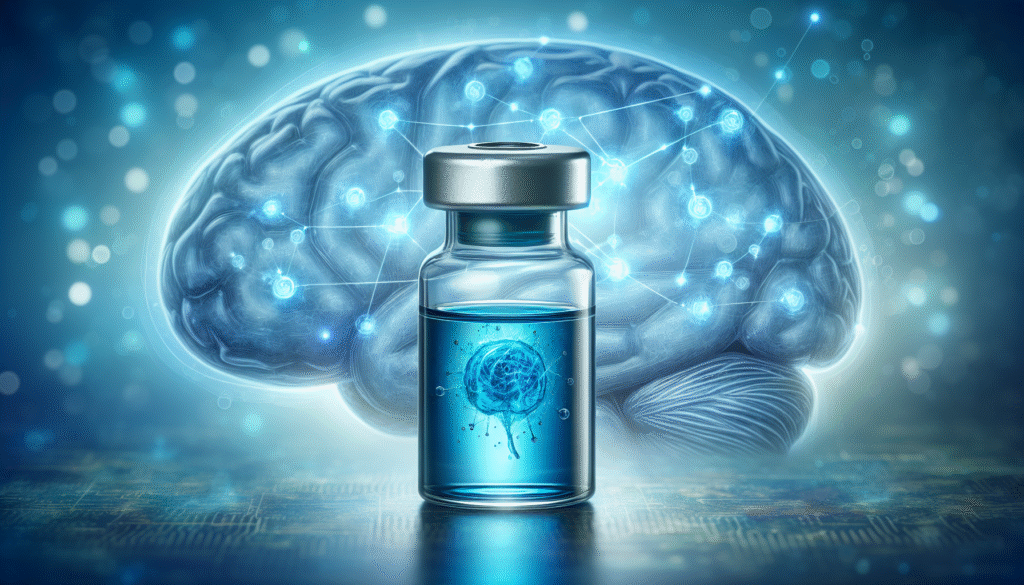
What if one compound could significantly influence how your brain metabolizes energy and maintains cognitive function? This may sound like the premise of a science fiction novel, yet Methylene Blue (MB) is making waves in neurobiology. This dye, once primarily used in medicine, has gained attention for its potential benefits in enhancing brain metabolism and energy levels. This article analyzes the effects of Methylene Blue on your brain, drawing on current research to illuminate its mechanisms of action and possible applications.

Understanding Methylene Blue
Methylene Blue is a synthetic dye initially used for various medical purposes, including treating methemoglobinemia, a condition where hemoglobin cannot effectively release oxygen to the body. However, its applications extend well beyond this singular use. While its blue hue makes it easily recognizable, the compound has also emerged as a promising agent in cognitive enhancement, particularly regarding brain energy metabolism.
Chemical Properties of Methylene Blue
Methylene Blue (chemical formula: C16H18ClN3S) is water-soluble, allowing it to easily cross cellular membranes—including the blood-brain barrier. The compound’s ability to penetrate this barrier is crucial in understanding its implications for brain metabolism. The unique structure of Methylene Blue lends itself to various redox states, enabling it to act as an electron transporter within mitochondria.
Its role as a photosensitizer also opens new avenues for research into its potential therapeutic applications when combined with light. These multidimensional properties mark Methylene Blue as a significant focus of research in neurobiology.
Mitochondrial Function and Energy Metabolism
Mitochondria, often referred to as the powerhouses of the cell, play a pivotal role in energy metabolism. These organelles convert nutrients into adenosine triphosphate (ATP), the cell’s energy currency. An understanding of mitochondrial function is crucial for grasping how Methylene Blue influences brain metabolism.
The Role of Mitochondria in the Brain
Your brain uses approximately 20% of your body’s energy despite constituting only around 2% of your body weight. This high-energy requirement stems from the need for continuous communication between neurons, the maintenance of ionic gradients, and the synthesis of neurotransmitters. Mitochondria in neurons are specialized to meet these demands through aerobic respiration, where glucose and oxygen are converted into ATP.
Energy Production and Methylene Blue
Research indicates that Methylene Blue may enhance mitochondrial function by improving the efficiency of ATP production. One mechanism involves acting as an alternative electron carrier within the mitochondrial respiratory chain. Specifically, Methylene Blue increases the flow of electrons which can mitigate the negative effects of reactive oxygen species (ROS) generated during the electron transport process.
Furthermore, MB has been shown to stimulate the activity of cytochrome c oxidase, an essential enzyme within the electron transport chain. By aiding in this process, Methylene Blue significantly boosts energy production, thereby supporting cognitive processes.
The Neuroprotective Effects of Methylene Blue
The human brain is vulnerable to injury and degeneration due to various factors such as aging, oxidative stress, and neurodegenerative diseases. This vulnerability has led researchers to investigate compounds that may exert neuroprotective effects. Methylene Blue has emerged as a promising candidate in this domain.
Reducing Oxidative Stress
Oxidative stress occurs when there’s an imbalance between the production of free radicals and the ability of the body to counteract their harmful effects. In the brain, oxidative stress is linked to neurodegenerative conditions such as Alzheimer’s disease and Parkinson’s disease. By effectively quenching ROS, Methylene Blue reduces oxidative damage, thereby protecting neuronal integrity and function.
Enhanced Cognitive Function
Several studies have demonstrated that Methylene Blue improves various cognitive functions, including memory and learning. Animal studies reveal that low doses of Methylene Blue can lead to improved spatial memory, while human studies show similar promising results in enhancing working memory.
Application in Neurodegenerative Diseases
Due to its neuroprotective and cognitive-enhancing properties, Methylene Blue has gained attention for its potential use in treating neurodegenerative disorders. Research is ongoing to evaluate its efficacy in conditions like Alzheimer’s disease. Early findings suggest that Methylene Blue may slow down cognitive decline by enhancing mitochondrial function and reducing oxidative damage.
Dosage and Administration of Methylene Blue
When considering the use of Methylene Blue, understanding the appropriate dosage and administration is crucial. The compound is available in various forms, including injections and oral tablets. However, the correct dosage can depend on individual health factors and specific therapeutic objectives.
Recommended Dosage
Preclinical and clinical studies on Methylene Blue have used doses ranging from 0.5 mg/kg to 4 mg/kg body weight. Low doses are typically favored due to the potential benefits in enhancing cognitive function and reducing toxicity. Higher doses may exhibit adverse effects, such as serotonin syndrome, particularly in individuals taking certain medications.
Understanding that Methylene Blue’s beneficial effects are often dose-dependent is paramount. Consulting with a healthcare professional before beginning any supplementation regimen is essential.
Potential Side Effects and Interactions
Although Methylene Blue is generally considered safe at low doses, potential side effects include gastrointestinal discomfort, headaches, and phototoxicity. Given its interaction with various medications, particularly those affecting serotonin levels, caution is warranted.

Mechanisms of Action: How Methylene Blue Enhances Brain Energy Levels
Understanding how Methylene Blue operates at a cellular level can provide insight into its potential applications. Its multifaceted mechanisms play a crucial role in energizing the brain and augmenting cognitive functions.
Electron Transport Chain Modulation
Methylene Blue’s role as an alternative electron carrier in the mitochondrial electron transport chain is significant. By facilitating electron flow and reducing the accumulation of ROS, Methylene Blue helps maintain mitochondrial efficiency, which is critical for sustaining high energy levels in neurons.
Improving Mitochondrial Biogenesis
Recent studies suggest that Methylene Blue may improve mitochondrial biogenesis— the process of generating new mitochondria within cells. An increase in mitochondrial density can enhance cellular energy production capacity, contributing to improved brain function.
Neurotransmitter Regulation
Beyond enhancing energy metabolism, Methylene Blue may also influence neurotransmitter systems. The compound appears to promote increased availability of certain neurotransmitters, including dopamine. This may account for some of the cognitive-enhancing effects observed during Methylene Blue administration.
The Future of Methylene Blue Research
As research on Methylene Blue progresses, exciting possibilities continue to emerge. Early findings indicate more than just basic applications but also innovative therapeutic strategies for cognitive enhancement and neuroprotection.
Novel Applications in Cognitive Enhancement
Not only is Methylene Blue being studied for its neuroprotective properties, but it is also being investigated for uses in hyperbaric oxygen therapy and as a potential treatment for conditions like chronic fatigue syndrome. The ongoing study of its mechanisms will likely lead to broader applications in cognitive enhancement and mental health.
Potential in Age-Related Cognitive Decline
Given the aging population and the increase in age-related cognitive decline, Methylene Blue presents a timely area of research. Understanding its potential role in maintaining cognitive health could lead to groundbreaking strategies for prolonging cognitive longevity.

Conclusion
Methylene Blue is more than just a synthetic dye; it holds the potential for profound implications in brain metabolism and energy levels. Through its unique mechanisms—enhancing mitochondrial function, reducing oxidative stress, and potentially influencing neurotransmitter regulation—it offers hope for cognitive enhancement and neuroprotection. The future of research surrounding Methylene Blue is bright, and continued inquiry into its capabilities may unlock new avenues for treating cognitive decline and neurodegenerative diseases.
As with any potential supplement or treatment, ensuring appropriate dosage and understanding possible interactions is essential. Consultation with healthcare professionals can help you navigate the complexities of health interventions. The future may very well see Methylene Blue play a crucial role in the quest for cognitive longevity and improved mental health.